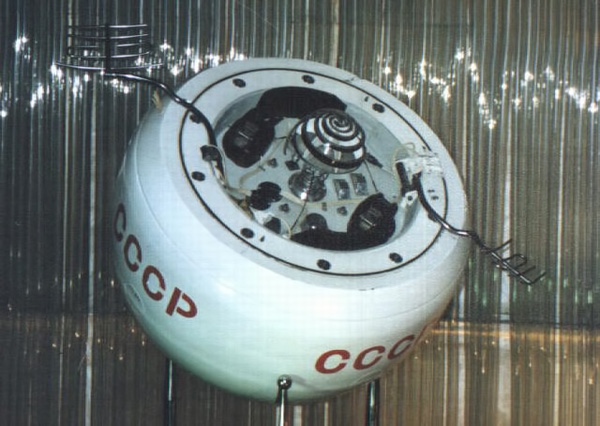Raiders of the Lost Venus Probe: a post-mortem of an interesting reentry and the confusion it leftby Marco Langbroek and Dominic Dirkx
|
| Maybe, one day, something odd with Cyrillian markings will wash up on an Australian or Indian beach. |
The media attention to this unusual reentry was unexpectedly high. News venues like the Daily Mail featured spectacular headlines with “Out-of-control Soviet satellite Kosmos could smash into the Earth TODAY”. All this for an object weighing about 500 kilograms and one meter in diameter, with a risk decidedly lower than that of the reentry of a Falcon 9 upper stage.
And now it has finally reentered, the big question on everybody’s mind is: where did it reenter, and when exactly? Is there a Soviet time capsule full of ancient (well: 1970s) technology and a few Communist trinkets—the Soviet Union reportedly put patriotic medals in these landers—to be found and collected somewhere?
It is very frustrating, but we cannot give a clear answer to that question, much to the dismay of some journalists. That it splashed down somewhere in the Indian Ocean seems to have the best papers, on the face of several reentry model results. Maybe, one day, something odd with Cyrillian markings will wash up on an Australian or Indian beach.
Several groups followed the doomed probe as it was coming down the months, weeks, days, and hours before the reentry, and used each new orbit update to run reentry models, trying to forecast when and where it would meet its demise. This included us at the Aerospace faculty of Delft University of Technology (TU Delft) in the Netherlands, where we were using the upcoming reentry as a test case for a reentry model we have created using the open-source TU Delft Astrodynamics Toolkit (Tudat) developed and maintained at our faculty. Our final assessment with Tudat was reentry around 6:40 UTC near 38 degrees south and 130 degrees east, just south of Australia. But that assessment has a notable uncertainty interval of 1.5 hours on either side of the nominal value (i.e. two full orbital revolutions).
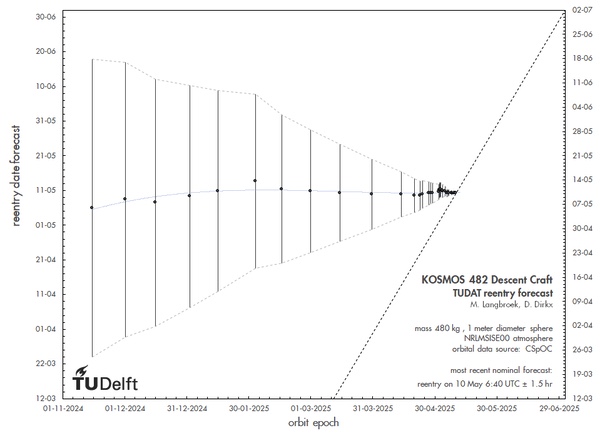 Figure 1: Evolution of the TU Delft Tudat reentry forecast from November 2024 to May 2025. Over the last half year, the model prognosis has consistently hovered around May 9-10, 2025. |
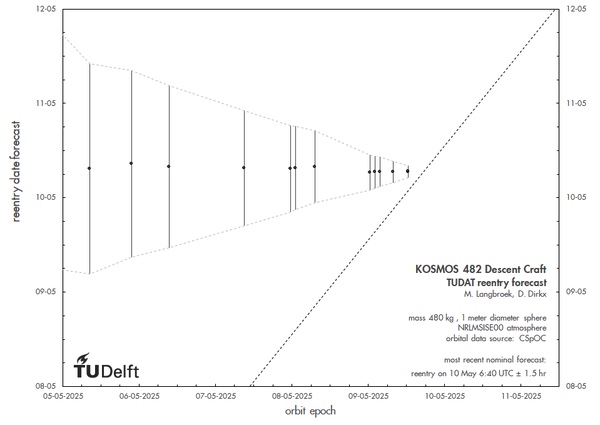 Figure 2: Evolution of the TU Delft Tudat reentry forecast from 5 to 10 May 2025. |
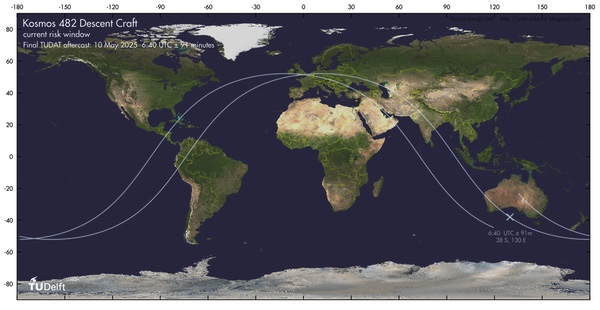 Figure 3: Nominal reentry position and time by the TU Delft Tudat model, and the uncertainty interval. The blue line is the trajectory over the uncertainty interval. |
Likewise, reentry models by other groups—the US DoD (CspOC), ESA, EU-SST, and the Aerospace Corporation to name a few—were assessing the reentry, all producing somewhat different results. Although all projected the reentry nominally on the same orbital revolution (looking at the nominal reentry time forecasts, ignoring the considerable error margins), they spread widely in geography. The map below shows the nominal (so excluding error margins) final result of the reentry modelling by various organizations.
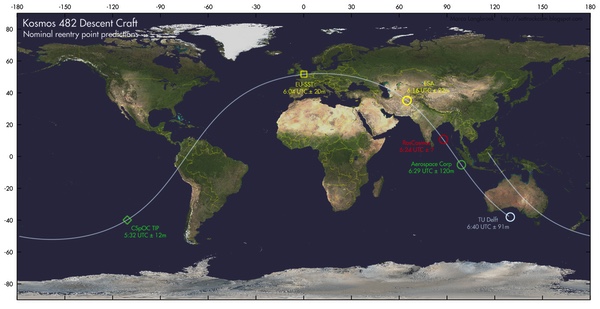 Figure 4: Nominal geographic reentry locations (i.e. without their error margins) for the Kosmos 482 Descent Craft from reentry modelling by several organizations. |
The table below lists the same final assessments with their error margins. The listed nominal geographic positions for the center times are our estimates, based on these times. Note that an error of one minute in time equals an almost 500-kilometer error in geographic position.
Table 1
| Source | reentry date/time & uncertainty | LAT | LON | |
|---|---|---|---|---|
| Tudat (TU Delft): | 10 May 06:40 ± 91 min UTC | aftercast | 38 S | 130 E |
| Tudat (TU Delft): | 10 May 06:39 ± 91 min UTC | forecast | 36 S | 127 E |
| Aerospace Corp: | 10 May 06:29 ± 120 min UTC | forecast | 5 S | 99 E |
| Roscosmos: | 10 May 06:24 ± ? min UTC | aftercast | 11 N | 88 E |
| ESA's Space Debris Office: | 10 May 06:37 ± 197 min UTC | forecast | 31 S | 120 E |
| ESA's Space Debris Office: | 10 May 06:16 ± 22 min UTC | aftercast | 35 N | 65 E |
| EU-SST: | 10 May 06:04 ± 20 min UTC | forecast | 52 N | 0 E |
| CSpOC TIP: | 10 May 05:32 ± 12 min UTC | aftercast* | 40 S | 111 E |
* this TIP cannot be correct as a positive radar detection from Germany at 6:04 UTC was reported by ESA, well outside the listed uncertainty interval
In the table, “forecast” means that the assessment was published before the actual reentry; “aftercast” that it is based on a post-reentry reassessment (including, among other things, better values for the actual space weather around the time of reentry used as input in the models, as forecasts used estimates of future space weather.)
| This highlights how limited geographic sensor distributions and limits in sensor tasking (as well as data sharing), influence the cadence of object tracking and timeliness of orbital data. |
The spread in results makes clear that reentry predictions are hard: there are too many factors that are not well-known involved. This includes variations in the actual state of the upper atmosphere, under influence of variable solar activity (the flux of solar particles into the upper atmosphere.) The atmosphere models used are, after all, only models, and in forecasting they have to work with estimated and averaged, and hence imprecise values for future solar activity. Hour-to-hour, minute-to-minute, latitude-to-latitude variations in space weather and atmospheric state are difficult to capture in a model. During the first few days of May 2025, space weather forecasts, when compared to reality, were wrong altogether, causing our reentry model to temporarily bump the reentry to May 11 for a few days.
Other imperfectly known factors include uncertainties in the actual mass and the actual drag surface presented by the spacecraft, and any variations over time in the latter. While literature generally cites a mass of 495 kilograms for the lander, our modelling actually best matches the historic decay of the orbit observed over the 53-year period 1972–2025,if we use a mass of 480 kilograms, so we used the latter in our modelling. As a showcase for the complications of modelling the dynamics, we could replace this 3% reduction in mass by a 3% reduction in drag coefficient or a 3% increase in drag area and obtain largely identical results.
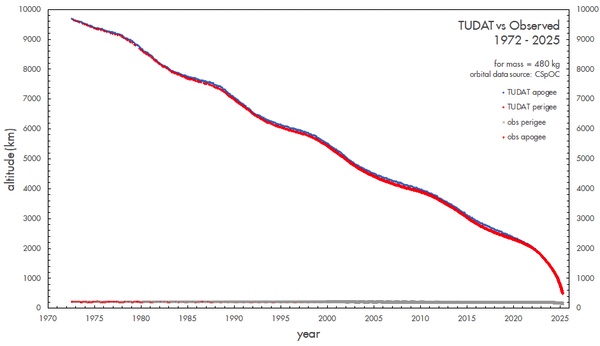 Figure 5: Match of observed and modelled orbital evolution for the Kosmos 482 Descent Craft from 1972 to 2025, for a mass of 480 kilograms and 1-meter diameter. |
The last orbit update for the Kosmos 482 Descent Craft available from CSpOC has an epoch near 00:36 UTC on May 10, some six hours before the reentry is believed to have happened. That is a long time gap and a large window of fast orbital evolution, with plenty of room for uncertainties to develop. However, there are some constraints from later observations. ESA has stated in a blog post on the reentry that there was a last radar detection from Germany (by TIRA) of the object on orbit at 6:04 UTC, and a no-show one revolution later at 7:32 UTC. This would constrain the reentry to somewhere in the interval 6:04–7:32 UTC on May 10. Based on that last radar detection, ESA revised their nominal reentry point forecast from very close to our Tudat estimate, over west Australia, to over the southwest Asian mainland in their aftercast.
This highlights how limited geographic sensor distributions and limits in sensor tasking (as well as data sharing), influence the cadence of object tracking and timeliness of orbital data. Gaps of half a day or even a full day or more between orbit updates for satellites are not uncommon: in its the last two weeks, often only one orbital update per day was published for the Kosmos 482 Descent Craft, and late April updates halted for three consecutive days altogether. In addition, publishing new orbit updates sometimes is a slow process, with elements only published half a day or more after the epoch of the orbit. That’s not a problem for your average piece of orbiting space debris, but for an object with a quickly evolving orbit about to reenter, one would ideally wish for very frequent detections and frequent timely orbit updates. But reality is different.
What is very unfortunate, is that in this particular case there has not been a high-accuracy post-reentry final TIP (Time of Impact Prediction) published by CSpOC. It has in the past sometimes published post-reentry final TIPs of very high accuracy (listing uncertainty in time as ± 1 minute) that usually highly correlate with actual sightings of the reentry fireball from the ground. Jonathan McDowell and the first author of this article believe that these very accurate final TIPs likely are not based on a reentry model (as “normal” CSpOC TIPs are), but are based on actual observations of the reentry fireball by space-based US military sensors, such as SBIRS satellites. Alas, no such final TIP has been published. And the last TIP that CSpOC did publish clearly is incorrect in light of the radar detection from Germany at 6:04 UTC, which falls outside the TIP uncertainty window.
The Russian State Space Agency RosCosmos published a statement on Telegram claiming that their “calculations” indicate that the reentry started at 6:24 UTC west of the Andaman islands in the Indian Ocean, and ended west of Java, Indonesia.
| The relevant area was in daylight, and most of it is ocean, which would explain why ground-based observations of the reentry are lacking. |
In Western media, this statement surprisingly has been taken as a kind of “final” verdict on the matter, as if this location and time would be more authoritiatve and accurate than the reentry model results of other organizations. There is no evidence it actually is. The Roscosmos assessment is likely the result of a reentry model extrapolating from an earlier last detection and orbit update—presumably from tracking by an instrument in Russia—just like the other model results, rather than an “exact” determination. There is no information provided about the uncertainty window for this result: one minute, 15 minutes, one hour? Hence it is impossible to assess how meaningful the listed positions and time really are. It also remains an open question how serious one should take Russian state organization statements these days, as sometimes pragmatic considerations (such as deliberate denial of responsibility or risk) are leading.
Looking at the various model results, we feel that the reentry most likely happened between about 6:15 and 6:45 UTC (10 May 2025), over southwest Asia or the Indian Ocean. The relevant area was in daylight, and most of it is ocean, which would explain why ground-based observations of the reentry are lacking.
Added note: the earlier Space Review article from 2022 discussed the history of the Kosmos 482 Descent Craft, and several related objects that reentered during the 1970-ies and early 1980-ies, in light of questions whether the object was the lander only, or perhaps included parts of the Venera main bus. A new piece of information has since popped up through the efforts of Anatoly Zak, who unearthed a declassified Russian military memo that points out that after the failure to leave Earth orbit, the lander was deliberately released from the Venera main bus by its operators.
Note: we are now moderating comments. There will be a delay in posting comments and no guarantee that all submitted comments will be posted.
